Copyright & Fair-use Agreement
UNLV Special Collections provides copies of materials to facilitate private study, scholarship, or research. Material not in the public domain may be used according to fair use of copyrighted materials as defined by copyright law. Please cite us.
Please note that UNLV may not own the copyright to these materials and cannot provide permission to publish or distribute materials when UNLV is not the copyright holder. The user is solely responsible for determining the copyright status of materials and obtaining permission to use material from the copyright holder and for determining whether any permissions relating to any other rights are necessary for the intended use, and for obtaining all required permissions beyond that allowed by fair use.
Read more about our reproduction and use policy.
I agree.Information
Digital ID
Permalink
Details
More Info
Rights
Digital Provenance
Publisher
Transcription
H ors have criticized this attempt of the Restatement to place greater obstacles in the way of the running of the burden than are required for the running of the benefit. Only two questionable cases can be cited in support of this distinction between the running of the benefit and of the burden on the requirement of privity, while in several cases the court has expressly denied the right of the assignee of the covenantee to sue the o- riginal covenantor because of lack of privity of estate between the covenantor and covenantee, which prevented the benefit from running to the covenantee's assignee." In view of the foregoing authorities I think it will be necessary for us to accede to‘the position taken by Mr. Powell that the covenant must be contained in the deed from the Railroad to the Water Company instead of the Railroad's joining in a deed from the Water Company to the District and in such deed covenanting not to drill wells upon Railroad land. Another problem involved is the problem of whether the Railroad may be liable for a breach of the covenant after if has conveyed the lands burdened with the covenant. Mr. Powell concedes there are cases on- both sides of this question, but he believes that if the covenant is properly drawn, the covenantor should be relieved of liability after it has conveyed its land. In spite of the rather strong statement hereinafter noted by one of the text writers, most of the cases which I have seen support his view. In 3 Tiffany Real Property, page 447, it is said: 5.

